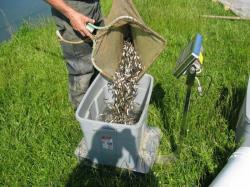Walleye Egg Collection 101
The Ohio Division of Wildlife has been asked to collect 200 quarts of walleye eggs from Mosquito Reservoir for hatchery production this spring.
from The Fishing Wire
What does this mean? How do they do it? Why do they do this? What is the end result?
From start to finish…
The Net Set• ODNR Crews set 16 trap nets on Mosquito Reservoir to collect fish.
• Nets are set in shallow water- 14 feet deep or less.
• Nets are set from the causeway to the dam, primarily on the east side
• Fish hit the lead (red line) and swim toward deeper water towards the work up area
• IF YOU SEE A NET, PLEASE STAY AWAY FROM IT!!!!!
Running the Nets
• If it swims, we catch it! Walleye, crappie, perch, sunfish, and catfish are commonly caught, but we do catch pike, bass, and an occasional mudpuppy.
• Fish are netted from the end of the net and processed on the boat.
• Female walleyes ready to spawn are the target. 15 – 22″ is normal- 25″ and up have been seen!
• Female walleye eggs are mixed with either walleye sperm to make walleye OR sauger sperm to make saugeyes.
• Each quart of walleye eggs taken can yield 130,000 fish.
• A large female walleye can have 2 quarts in her!
At The Hatchery
• Fertilized walleye eggs are taken back to Senecaville State Fish Hatchery (Guernsey Co.).
• Eggs can die off due to low water flow, fungus, poor fertilization, or rapid temperature changes.
• Fish are then hatched off in jars in about 3 weeks.
• Fish can either be stocked as fry (see above) or fingerling (see right), depending on the lake.
• Fry are 1/4″ long, are stocked in late April, and typically stocked at a rate of 1000 / acre of water.
• Fingerling are 1-2 inches long, are stocked in late May, and are typically stocked at a rate of 100 / acre of water.
The End Result?
• Fish stocked in the spring will grow to 8 inches by September.
• More importantly, fish stocked in 2012 will be about 15 inches within 2 years. They grow REALLY fast with how much gizzard shad there is for them to eat!
• We know that some fish will die throughout this process. Taking the eggs from the female walleye is rough on them, especially when the water is warmer.
• Also, stocking such small fish will lead to some of them dying. If we get 1/10 of 1% (0.001) of the fish we stock to live to reach 15″, we are doing great!
But the bottom line is that without these efforts, walleye fishing on most of our inland lakes would not exist. Natural reproduction is not consistent enough to keep these high quality walleye fisheries going each and every year. Habitat is poor, and the conditions for a good natural spawn are rarely achieved- see Lake Erie!
The Ohio Division of Wildlife conserves and improves fish and wildlife resources and their habitats for sustainable use and appreciation by all.


